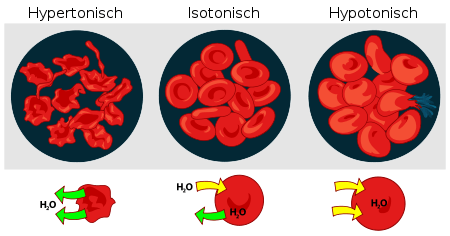Diffusion
If you put a dye pill in a glass of water, it will start out concentrated in one place, but as the atoms of water move around by Brownian motion they knock the atoms of dye around until it spreads throughout the glass coloring the water evenly. This property of matter is called DIFFUSION.
Osmosis and cells
Osmosis is something that all cells must learn to deal with. Different cells use different strategies to avoid being damaged by osmotic pressure.
An animal cell in a hypotonic solution is in danger of lysis (breaking apart) because the water will flow into the cell making it bulge and expand. A cell in a hypertonic solution will shrivel and lose water (plasmolyze).

Plant cells have a cell wall which prevents lysis when they are in a hypotonic solution. The cells expand until they hit the cell wall and then get no bigger. This is why we can put a flower in a glass of water without worrying about the cells bursting.
Plant cells, however, can plasmolyse. If you put a plant into salt water the cells will shrivel as water rushes out of the cells which have now become a hypotonic solution. Plant cells are not designed to work under such conditions, and so most plants will die if you try to grow them in salt water.
